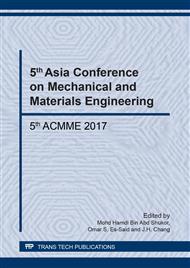[1]
S. M. Ravi, B. M. Prabhu, T. R. Raju and P. N. Bindu, in: Long-term Effects of Postnatal Aluminium Exposure, Indian J Physiol Pharmacol. (2000).
Google Scholar
[2]
P. Kovac and L. Sidjanin, in: Investigation of Chip Formation during Milling. (1997).
Google Scholar
[3]
Rasidi, I. I., Noor Hakim Rafai, E. A. Rahim, S. A. Kamaruddin, H. Ding, and K. Cheng. An investigation of cutting mechanics in 2 dimensional ultrasonic vibration assisted milling toward chip thickness and chip formation. In IOP Conference Series: Materials Science and Engineering, 100(1)1, 012057, (2015).
DOI: 10.1088/1757-899x/100/1/012057
Google Scholar
[4]
L. Zhou, in: Machining Chip-Breaking Prediction with Grooved Inserts in Steel Turning PhD thesis, Worcester Polytechnic Institute. (2001).
Google Scholar
[5]
S. Kalapakjian: Manufacturing Processes for Engineering Materials. Addison Wesley, third edition. (1997).
Google Scholar
[6]
Rasidi, Ibrahim, E. A. Rahim, A. A. Ibrahim, N. A. Maskam, and S. C. Ghani. The effect on the application of coolant and Ultrasonic Vibration Assisted Micro Milling on machining performance., In-Applied Mechanics and Materials, vol. 660, pp.65-69. Trans Tech. Publications, (2014).
DOI: 10.4028/www.scientific.net/amm.660.65
Google Scholar
[7]
Rahim, E. A., Rahim, A. A., Ibrahim, M. R., & Mohid, Z. (2016). Experimental Investigation of Supercritical Carbon Dioxide (SCCO2) Performance as a Sustainable Cooling Technique Procedia CIRP, 40, 637-641.
DOI: 10.1016/j.procir.2016.01.147
Google Scholar
[8]
Rasidi, I., Rahim, E. A., Ghazali, M. I., Chai, M. H., & Goh, Z. O. (2014).
Google Scholar
[9]
Agrawal, A., Goel, S., Rashid, W. Bin, & Price, M. (2015). Prediction of surface roughness during hard turning of AISI 4340 steel (69 HRC). Applied Soft Computing Journal, 30, 279–286.
DOI: 10.1016/j.asoc.2015.01.059
Google Scholar
[10]
Bartarya, G., & Choudhury, S. K. (2012). Effect of cutting parameters on cutting force and surface roughness during finish hard turning AISI 52100 grade steel. In Procedia CIRP.
DOI: 10.1016/j.procir.2012.05.016
Google Scholar
[11]
Costes, J. P., Guillet, Y., Poulachon, G., & Dessoly, M. (2007). Tool-life and Wear Mechanisms of CBN Tools in Machining of Inconel 718. International Journal of Machine Tools and Manufacture, 47(7-8), 1081–1087.
DOI: 10.1016/j.ijmachtools.2006.09.031
Google Scholar
[12]
Gaitonde, V. N., Karnik, S. R., Figueira, L., & Paulo Davim, J. (2009).
Google Scholar


